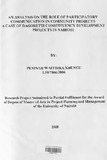| dc.description.abstract | This study was conducted on two community development projects in Dagoretti Constituency
in Nairobi. It sought to establish the role of communication in community development
projects. In this study, two projects were identified, one as a successful project and the other
as an unsuccessful project. Success was measured in terms of implementation within time
schedule, budget, scope and sustainability. The unsuccessful project was not a failure but a
project facing challenges in the four aspects mentioned. Communication was then analyzed in
the two projects using data collected from the field.
This report has five chapters. Chapter 1 is the Introduction. This gives the background of the
study and the objectives, the main objective of the study being to establish if there is a
relationship between participatory communication in a project and the success of that project.
The conceptual framework is also discussed here. It shows the communication process as a
circuit, where a project is taken through the various stages of implementation and its success
evaluated. There is a feedback process where corrective actions are taken and the project is
taken through to completion.
Chapter 2 gives a literature review of previous studies. It gives a historical perspective of
community development projects citing examples from Buganda Kingdom and the Kikuyu
community. This chapter also cites examples of community projects in modern society
particularly from India. Other studies carried out on subject of communication and
community development projects are also discussed.
Chapter 3 covers the research methodology, which outlines the research design, scope of
study, population and sampling frame, data collection strategy, instrument reliability and
validity, and limitations of the study. This study was both qualitative and quantitative.
Qualitative data was initially used to select the successful and the unsuccessful project.
Quantitative data was used to estimate performance parameters. Quota sampling was used to
collect relevant information for analysis. Data regarding opinion was collected from the
public using questionnaires. Data regarding factual information was collected through
interviews, review of existing literature and the Constituency Development Fund (CDF)
website.
Chapter 4 covers results from the analysis of data and discussion of findings. Here, a
descriptive and a statistical analysis was carried out. The findings are presented in tables,
figures and photographs. The correlation between budget and each of the parameters of
schedule, contractual information and scope were computed. These findings are then
discussed.
Chapter 5 gives the summary of findings, conclusions and recommendations. The study
concludes that participatory communication has a very important role to play in the success of
community development projects. The public involvement in community projects will not be
felt unless the public has information to help them monitor the project through, from selection
to close down. The study goes further to give feedback (suggestions) on how the unsuccessful
project can be fast-tracked by offering suggestions on how to sustain the project in the long
term and also how to involve the community. It also gives recommendations on how
communication can be improved in community development projects. | en |

